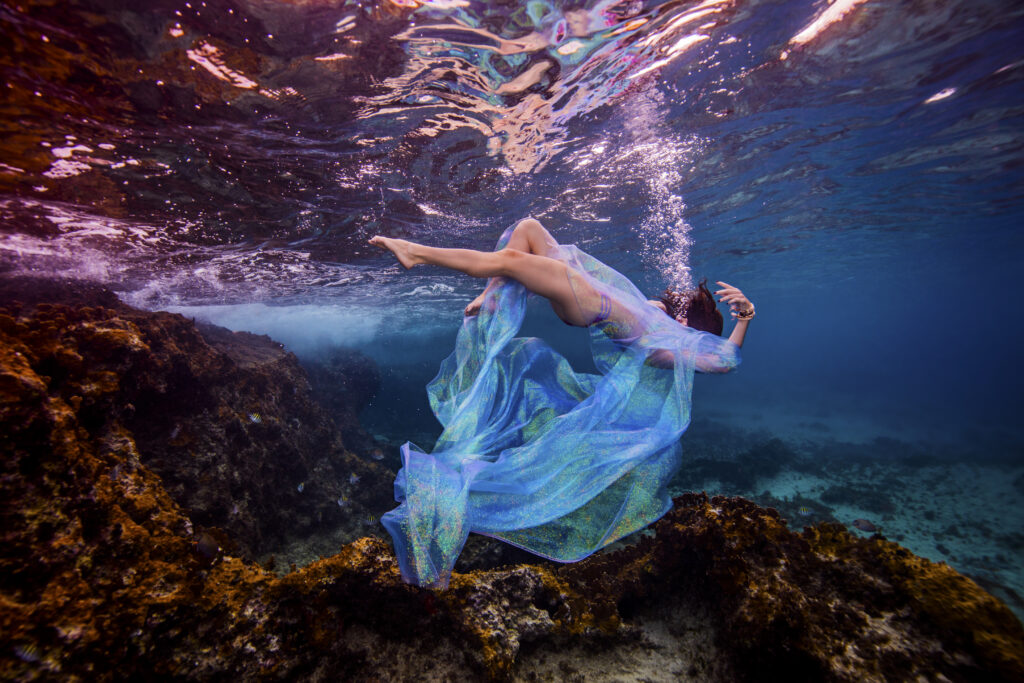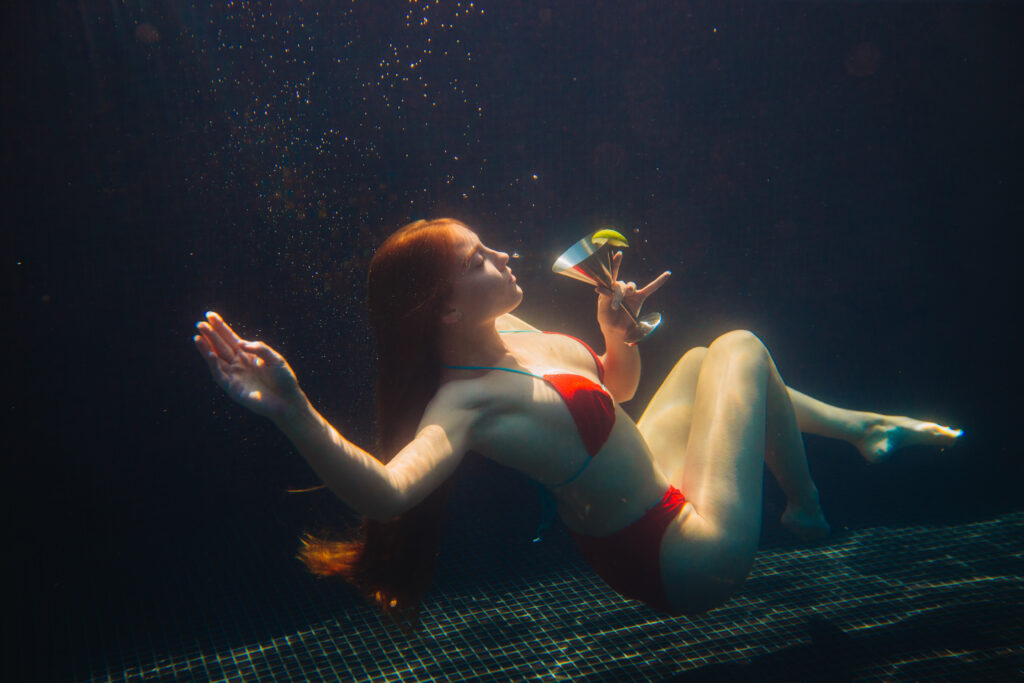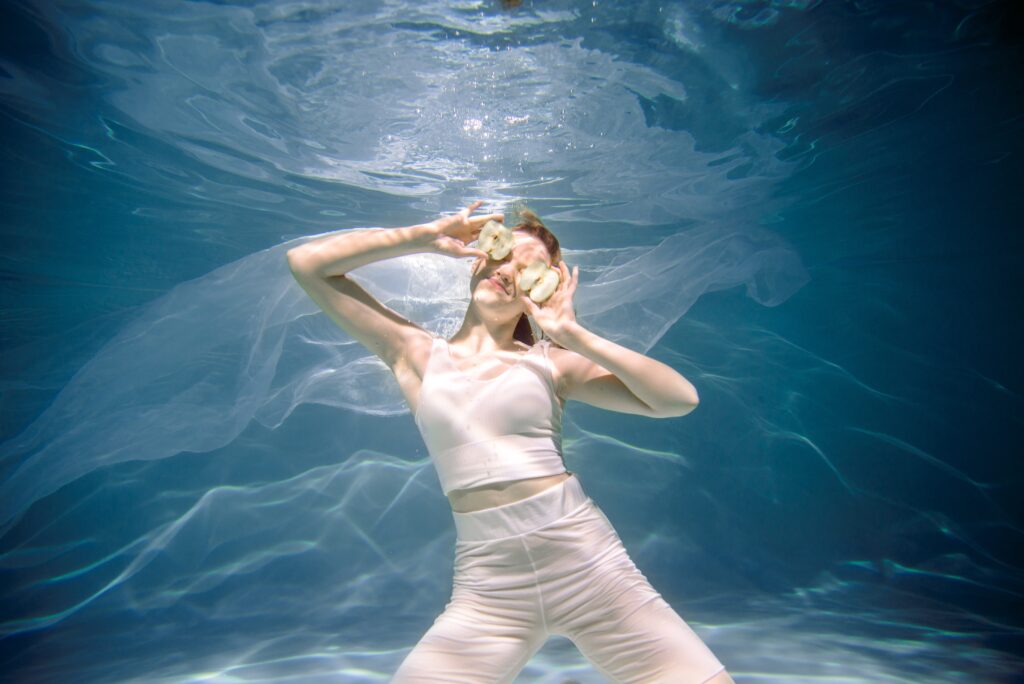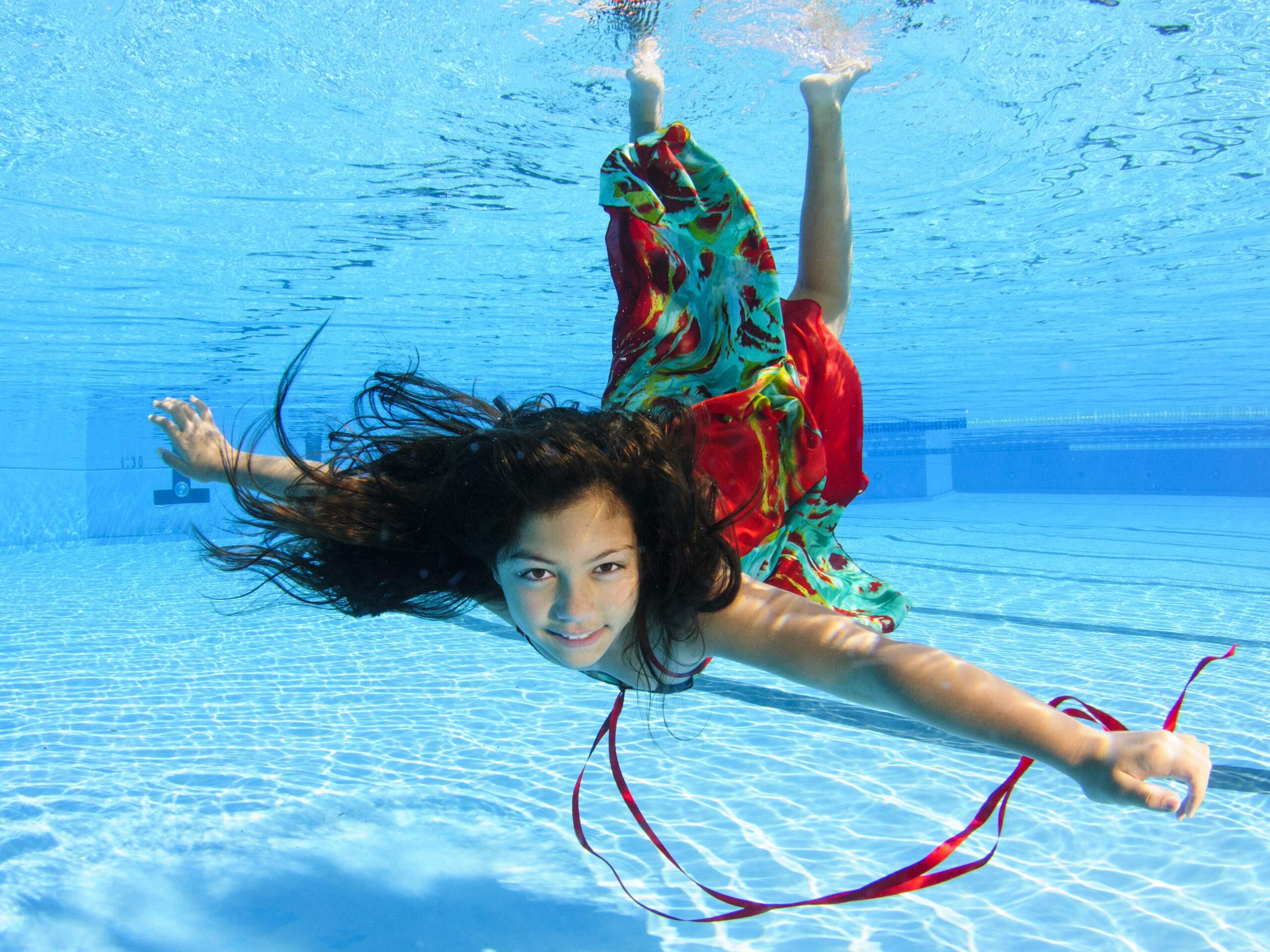Capturing Art Beneath the Waves
Underwater photography is more than taking pictures. It’s about capturing a world where light, water, and the human form dance in perfect harmony. However, this captivating art form is challenging.
One must master the intricate relationship between light and water. Also, one must capture the beauty of models submerged in liquid realms. Photographers can maximize underwater photography by knowing how water bends and refracts light. They can turn every ripple into a work of art. This skill turns photography into a dynamic exploration of vulnerability, movement, and emotion. We understand the complexity of capturing such fleeting moments. The fluidity of water is enchanting yet elusive. The photographer and the model demand patience, creativity, and skill. With the right techniques, you will overcome these challenges. You will create visual masterpieces. Each shot will tell a story.
Every frame will explore the beauty that transcends earthly constraints. Ready to immerse yourself in this mesmerizing world? Let’s explore how to master underwater photography. Create works that resonate with grace and power.
Understanding Underwater Photography Essentials
Underwater photography is an art. It needs technical skill and creativity. This is especially true for capturing the subtle beauty of nude and model art underwater. Light and water can be tricky. Light often behaves in unexpected ways. Mastering artificial lighting is crucial here. Strobes or underwater flashes can significantly enhance visibility. They also highlight your subject against the liquid backdrop. Using natural sunlight in shallower waters adds a unique texture. It gives the images an ethereal glow that is hard to replicate on land.

The fluidity of water encourages a more dynamic engagement with composition. As your subjects move in this weightless environment, capture new angles. Water’s density gives it unmatched buoyancy. Models can seem airborne, opening new ways to express surreal, gravity-defying art. Another key point is to master buoyancy control. You must float without restriction while you control your shot framing. This ensures not only a harmonious
Mastering Lighting Techniques Underwater
Underwater lighting is an art and a science. It has unique challenges and possibilities that differ greatly from those on land. Light behaves strangely under the waves. It creates surreal effects. They can be stunning but unpredictable. To master underwater lighting, you must know how water affects light. It absorbs, reflects, and refracts it. Colors fade at different depths. Red goes first, then orange and yellow. You find yourself in a world dominated by blue and green. This makes artificial lighting essential. Photographers need to show all hues and the nuances of skin tones in model photography.
The key is learning to manipulate light sources to achieve the greatest impact. Using strobes or continuous lights can enhance textures like never before. They can highlight every elegant ripple or wave in hair or fabric. But you must position them about your subject. Position them off-axis for moody side lighting. It will stress muscle tone and soften harsh lines. We need to strike a balance between natural sunlight filtering through.
Use scene and lighting setups to create a blend. It must not overpower the original environment. This balance keeps shadows soft but defined. It adds depth without losing color authenticity.
When working indoors, use diffusers or reflectors to soften harsh light. This will flatter skin tones. Experiment with different color temperatures to match your subject’s mood. Warmer hues can evoke coziness and nostalgia. Cooler tones might convey modernity and edginess.
Also, knowing the inverse square law can improve your control over lighting intensity. Adjust the distances between lights and subjects with careful intention. You’ll fine-tune highlights and contrasts for each shot.
Also, don’t forget about gels. They can turn basic lighting into dramatic, colorful scenes. They’re creative tools. Colored filters on bulbs create a new atmosphere. They can give a romantic amber glow like the golden hour. Or, they can create a surreal blue tint like a moonlit night.
Artistry lies not only in skill but also in intuition, honed by practice. Photographers, chasing mastery, find that slight adjustments can yield stunning compositions. This ensures no two frames look the same, even in identical conditions. They must weave natural beauty with clever edits, extending storytelling beyond ordinary means.
Communicating with Models Effectively
In the surreal world of underwater photography, you must communicate with your model. It’s key to capturing great shots. Unlike land-based shoots, commands are easy to convey. Underwater sessions use a unique set of hand signals. Both photographer and model must master them beforehand. Pre-dive meetings are essential. Discuss the mood, style, and safety protocols. Also, agree on the sign language to use underwater. A good communication system ensures a smooth display of poses. It also embraces the current’s rhythmic dance.

Moreover, understanding your model’s comfort level is paramount. Being submerged can be overwhelming, especially when nude. It makes one vulnerable to nature and emotional exposure. A space that respects the model will amplify their grace in the water. Encourage feedback during safety breaks between sequences. There’s an angle they felt unsure about. Also, suggestions on backdrop movements could improve the frame’s story.
Effective communication isn’t about directing. It’s an exchange that fosters creativity. It allows familiarity with subtle shifts in body language. This leads to spontaneous, camera-caught moments that often become the project’s highlights. If the photographer and model connect before the dive, their work becomes art. It is very expressive. It creates harmony in its marine story.
Ensuring Safety and Comfort for Models
In underwater photography, safety and comfort for models are critical. They can affect the quality and authenticity of your shots. Rank open communication with your models. It builds trust and understanding. This is vital for nude underwater photography, where vulnerability peaks. A pre-shoot talk about boundaries and signals reduces the models’ anxiety. It ensures that both parties align on expectations.
Also, the unique challenges of water pressure and temperature are vital. They are key to a model’s well-being. Add frequent breaks during shoots. They will let models adjust to colder water and reduce visibility without stress. Use suitable gear, like breathable wetsuits or lightweight weight belts. They improve buoyancy control. These details create a better environment for stunning imagery.
Intertwine safety measures into your artistic workflow. First, practice new poses on land. Or, use experienced dive assistants who can intervene without delay if needed. It boosts security and fosters a free-spirited, creative atmosphere. When models feel safe in this aquatic playground, their self-expression becomes more open. This synergy shines through in every compelling frame captured beneath the surface.
Exploring Creative Poses and Angles
Underwater photography can be stunning. However creative poses and angles can make your images captivating. Water’s unique properties allow for graceful, flowing movements that land can’t. This invites models to try ethereal poses that enhance the aquatic scene. For instance, ask your subject to extend their limbs or arch their back. This can create striking silhouettes against the blue-green water. It’s vital to think outside the box. A simple change in posture can turn a plain shot into a work of art.

When considering angles, remember that light refracts in a different way underwater. This knowledge is key to capturing enchanting images. Shooting upward to the surface lets natural light dazzle your model. It emphasizes textures made by air bubbles and ripples. Downward shots provide a unique perspective. They show movement and reflections off the sandy floor and coral reefs below. Encourage adventurous positioning around diverse elements, like rocks and marine life. It will add depth and context.
Editing Tips for Stunning Final Images
Editing is as important as the shot itself. It can transform your underwater photos into stunning images. Start with color correction. Underwater lighting often tints photos bluish-green. Use white balance adjustments to restore natural skin tones. Also, highlight the model’s intricate details that an ocean’s embrace might hide. This can restore the warmth and intimacy vital in nude photography. It will ensure your images resonate more with viewers.
Next, pay attention to contrast and clarity. Water movement can blur or soften edges. Enhancing these elements will highlight key features. It will also preserve the ethereal quality of the underwater environment. Consider using localized adjustments. They can enhance specific areas while keeping others soft. This balances realism with artistic expression.
Remember that less can be more in post-processing. Avoid over-editing. It will ruin your shots’ authenticity. Let their natural grace and flow speak for themselves. Embrace subtlety. Use soft increases in saturation or gentle light gradients. This will create an atmospheric depth that is both intriguing and enchanting. You will honor the art form. You will invite viewers into a fantastic, aquatic world. It will blend reality and fantasy.
Elevate Your Underwater Photography Skills
Mastering underwater photography, especially for models and nudes, takes more than technical skills. It requires an artistic vision. Water is unpredictable. It can transform a moment into something extraordinary. The challenges are clear: to capture the beauty of the human form in water. Light refracts in various ways with each movement. Each wave alters the shot’s dynamics.
These factors make it difficult to create dynamic compositions and authentic moments. By embracing the fluidity of water, photographers can find art in every wave and ripple. Many photographers have created iconic underwater works. Their works captivate viewers with an ethereal beauty. They do this by fostering patience and experimenting with light, angles, and props. Think of underwater photography as painting on a living canvas. The natural ebb and flow of water affect each stroke of light and shadow. Like an artist finding their muse, you can find new possibilities with every shot. You can turn simple poses into compositions that evoke a sensation of another world. We know it’s frustrating to miss the perfect moment. But, with the right approach, you can master underwater photography.
With patience, rapport with your model, and experiments, you will master this art. You will create images that evoke curiosity, wonder, and admiration. As you continue this journey, remember that each challenge is a chance to improve your craft. With the right mindset and tools, you can take stunning images. They will resonate with you and your viewers. You’ll master the magic of underwater photography.
